Naturam non vinces nisi parendo
“You will not master Nature unless you obey Her,” said the Ancients. We must conform to Her fixed and indisputable laws to live in harmony with Her. Follow Her rules, and we will grow beautifully formed. Disobey Her, and She will deform us.
One of our best historical models for living compatibly with Nature is the Ancient Greek. Discipline, symmetry, beauty, strength, endurance, agility, and graceful harmony were admired, sought and often attained. The Persian Wars brought continued urgency and personal responsibility to Greek physical culture, and athletic games provided opportunity to put aside mundane strife in favor of activities more transcendent in form and nature. Thousands of years later, the Ancients still offer us a compelling and rational paradigm for physical education. From the Ancient Greeks, we are taught to see the human organism as a temporary vehicle through which divine unity and its subordinate stages can be sought, experienced and celebrated. The beauty of their language frees us from the decay of our own. Their art provides an ideal of the human form. The crumbling statues from their vanished cultures remind us that we too will be dust, and precious life should not be wasted on anything less than the pursuit and love of truth, beauty and wisdom.
From the historical, linguistic and sociocultural high ground, the physical educator’s responsibilities are enormous. "Nations have passed away and left no trace, and history gives the naked cause of it,” wrote Rudyard Kipling. “One single, simple reason in all cases; they fell because their people were not fit." Physical fitness includes physique, organic function and motor skills. All of these are impacted by posture and body mechanics.
Physical educators are the first line of defense against the unnatural influences that would deform our children. We are charged with guiding their motor development across the precarious bridge between childhood and adolescence. By the post-secondary level, we should be helping them add the final touches to their symmetrical, proportional and highly efficient forms. This is the ideal.
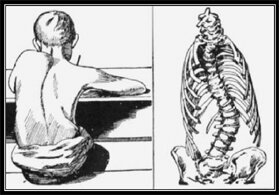 |
|
Ill-fitting furniture including flat desks is an unforgivable crime against children and youth. This is clearly a physical education issue.
|
The reality is that postural deformities and poor body mechanics are epidemic. Our precious youngsters are growing steadily more inert, malformed and clumsy. Fortunate are those who survive the education gauntlet with minimal damage and defects. It is not for a lack of historical evidence that we fail to effectively address the importance of good posture and body mechanics. It simply fell off the radar. Throughout the K-12 experience, youngsters fully capable of being taught to move gracefully and efficiently are victimized by an educational system that reinforces poor posture and body management skills. Probably more a crime of omission than commission, it remains to be seen whether the paradigm will shift.
Posture can be simply defined as, “Any position in which the body resides.” Good posture is a rational adjustment of the various parts to each other and of the body as a whole to its environment, task or work. The complex human organism is constantly in motion, so our posture is continually shifting. Body mechanics is posture’s close relative.
In 1932, the Orthopedics and Body Mechanics Subcommittee of the Hoover White House Conference on Child Health and Protection defined body mechanics as "The mechanical correlation of the various systems of the body with special references to the skeletal, muscular, and visceral systems and their neurological associations.” In other words, good posture and body mechanics are the foundations of motor development. If we taught nothing else, these would stand first in line for attention.
Ptosis (drooping or falling) is one of the primary problems associated with poor posture and body alignment. Skeletal ptosis manifests as a forward dropping of the head and various unnatural spinal curves with rotation and displacement. Visceral ptosis is another common condition where an organ or organs are displaced downward. The common hyperflexed slump seen among our children and adults displaces the lungs, heart, liver, intestines, and other vital organs. Exterior structural adaptations and indicators often include rounded shoulders, a flattened chest and protruding abdomen. Blood ptosis is a downward displacement and collection of blood in the splanchnic veins of the abdomen caused by insufficient nervous control of the splanchnic veins that must work against gravity to do their job. Weak abdominal muscles contribute to the problem.
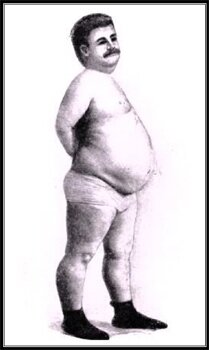 |
|
Ptosis is a common, unsightly and preventable postural deformity.
|
Occupation, disease, poor care in infancy, and malconceived physical education curriculums are a few of the obvious influences that can impair postural development. Other subtle and overlooked factors such as ill-fitting school furniture and extensive practice of specific sport skills early in life have not, in the recent past, been widely acknowledged. Overall, a complex set of issues involving heredity, environment and habits must all be considered, but one of Nature’s most important realities is that gravity molds us.
We are living clay, and Nature’s gravity is like the potter’s hands molding and shaping us. To exist in harmony with Nature, we must also live compatibly with gravity. One of the most enduring explanations for our troublesome relationship with gravity is that our ancestors were quadrupeds.
Somewhere in history, the theory goes, we decided to stand our quadruped skeleton up on its hind legs. With all its benefits, the upright bipedal posture presents some serious kinesiological challenges. Our many moving parts must constantly seek a center of gravity to avoid unwanted stress and strain. This requires tremendous muscular balance and neural coordination. Slight misalignments anywhere in the system create imbalance throughout the organism, and a pernicious cycle of structural and functional defects follows. A return to all fours is not a popular option, and not everyone agrees that postural deformities and the suffering that accompanies them are the price we must pay for walking on our hind legs. Dr. Robert M. Martin challenged the evolutionary theory of postural development in the early 1960’s, and his insights are still worth considering today.
Martin was born and spent his childhood in central Iowa during the early 1920s. His father was a chiropractor. Martin began training in the German system of gymnastics when he was around five years old. As a young man, he worked with Bernarr McFadden and taught at Turner Halls in Philadelphia and Kansas City. Martin eventually received degrees in Chiropractic from National College in Chicago, Osteopathy from the College of Osteopathic Medicine in Kansas City, and Medicine from the California College of Medicine in Los Angeles.
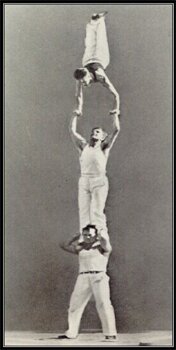 |
|
Young Martin, on top, was an accomplished gymnast
|
Martin began specializing in orthopedics early in his career, combining the healing power of movement to his medical treatments. Martin eventually migrated to Southern California, and was there in the early 1960’s when a new national interest in physical fitness, weight training and gymnastics was ignited under the leadership of President John F. Kennedy. Martin’s ideas began to appear in California-based health and physical fitness magazines. From his clinic in Pasadena, he combined decades of medical studies with the lessons he had learned as an Iowa gymnast, relying heavily on the power of rational movement to heal his patients.
In his 1975 book, "Cum Gravity—Living With Gravity", he wrote, “Being a physician who also practices and teaches gymnastics, one discovery became most pronounced to me. I found that my avocation was often helping people far more, in many ways, than my vocation. It was something of a miracle to see the wonderful transformation of ailing men and women into persons of commanding physique and stamina; some of these were individuals who at the beginning of their exercise programs seemed most unlikely to improve.”
Martin also questioned the common mainstream assertion that humankind is ill-equipped to walk upright. He wrote, “Hundreds of volumes (books, newspapers, magazines, etc.) have been published on backache. Almost all authors of these articles have a single premise: an assumption that low-back pain has plagued mankind ever since man assumed the unanimal like posture of the human when he changed from a quadruped to a biped. They relate that at the time this change occurred, man's neuro-musculoskeletal mechanism was that of a quadruped, and that as bipeds, our bodies are unable to live compatibly with gravity to this very day. It is declared that because man stands erect, his spine is unstable and gravity has devastating effects - not only on the vertebral column, but also on many other body functions. Thus, gravity is proclaimed to be man's foe.”
Martin challenged the notion that gravity is the villain, and humankind is doomed to ultimately be compressed and distorted by its unidirectional force and relentless pressure upon us. He argued that we do it to ourselves because we limit our motion. Martin wrote, “In the development of life on earth, no force is of greater consequence than the force of gravity. This force, without the intelligent use of exchange of postures, can deform, disable, or even destroy your body. Gravity applies its constant, relentless force to the pliable, moldable, movable structures of the body, much like a potter manipulates and molds clay. The resulting shape depends on how the force is allowed to apply. In both cases, to produce a shape and form of beauty, intelligent application of force is required.”
Martin suggested that there are six basic human postural categories. Three of them are common. Most people spend their lives, twenty-four hours a day, in them. The other three postures are uncommon. The common postures produce compression and shortening of stature while the uncommon postures decompress and elongate. In other words, the uncommon postures are compensatory. They mitigate the wear and tear caused by constantly assuming the dominant common postures.
Group I - Common Postures
Effects: Produce body compression and shortening of stature.
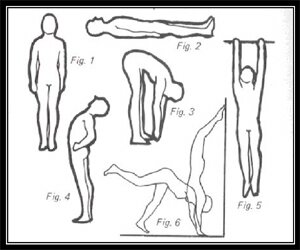 |
|
Martin’s six basic postures illustrate the importance of postural exchange.
|
Used: In work, play, rest, etc.
1. The ERECT POSTURE (Fig. 1) (The posture of Dominance)
a. Sitting
b. Standing
2. The HORIZONTAL POSTURE (Fig. 2) (The posture of neutrality)
a. Lying (On side, back, or front)
3. The FLEXED POSTURE (Fig. 3) (The posture of Accessibility)
a. Bending forward
Group II - Uncommon Postures
Effects: Produce body decompression and elongation of stature.
Used: To counter and correct adverse effects of gravity produced by the common postures
4. The EXTENDED POSTURE (Fig. 4) (The posture of Bending Backwards)
5. The BRACHIATED POSTURE (Fig. 5) (The posture of hanging by the limbs - upper or lower)
6. The INVERTED POSTURE (Fig. 6) (The Upside-down Posture)
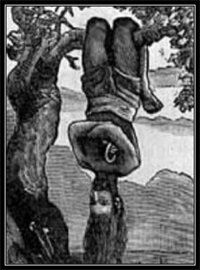 |
|
Yogis and Monks have inverted for centuries.
|
a. Hand stand
b. Forearm stand
c. Shoulder stand
d. Hanging by the lower limbs
Martin began inventing inversion equipment early in his career, but he was always quick to give credit to others who discovered the principles before him. Yogis and monks have inverted for centuries. Physicians in the Middle Ages used the Scamnum Hippocrates. It was a ladder-shaped bed used to facilitate inverted traction.
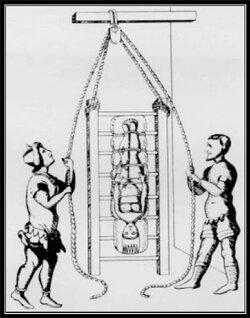 |
|
Physicians in the Middle Ages employed the Scamnum Hippocrates
|
In the late-1800’s, the great Strongman C.A. Sampson advocated the Roman Column. The famous body builder John Grimek trained upside down in the 1940’s and 50’s. Joseph Pilates also used extension, inversion and brachiation. Many chiropractors and physical therapists have used extension and inverted brachiation for decades. Physical educators are beginning to recognize the value of postural exchange, but mistakes in methodology can be at the expense of students.
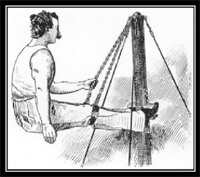 |
 |
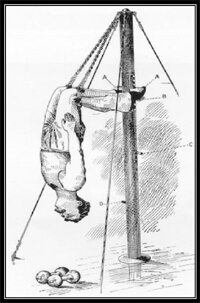 |
|
The great 19th Century strongman C.A. Sampson used the Roman Column.
|
Once deprived of the uncommon postures over time, spatial awareness deteriorates. Students and teachers must be taught to safely and profitably enter, assume and exit these uncommon postures. Progression, variety and precision are essential, as is correct spotting and instruction.
Many physical therapists and physical trainers have also recently rediscovered extension. In the early 1980’s, leaning backward was widely discouraged. Critics frequently called it hyperextension to stress its negative nature. Innovations such as the popular Swiss ball, Body Bridge and numerous other extension devices now provide tools to safely teach and practice it. Unfortunately, it is not uncommon in our universities today to still hear professors of exercise science or physical education warning against extension. Inverted postures like handstands, shoulder stands and forearm stands are also often contraindicated or simply overlooked.
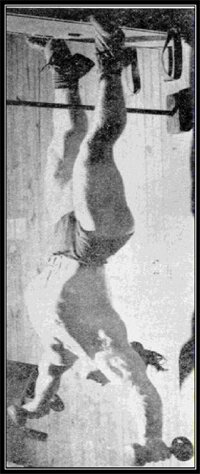 |
|
Body Building legend John Grimek lifted light weights while inverted.
|
Inversion tables and boots were generally ignored or deplored by most physical educators when people across the country started using them in the early 1970’s. Many physical educators based their opinions on 1980’s research that warned against turning the body upside down. Herbert Devries, Ph.D. put the exaggerated risk of increased arterial blood pressure and cerebrovascular damage caused by inversion to rest in 1985 when he wrote; “Considerable valid research data on the use of inversion devices to relieve low back pain have been published in the medical literature. Unfortunately, the information has been distorted and sensationalized in the lay press, giving rise to confusion. With proper precaution, full inversion using an oscillating inversion device probably presents no risk to normotensive healthy persons.”
I began teaching decompression and mobilization in physical
education skills courses at The University of Iowa in the early 1970’s. Using a device called a Physicare Machine and later Dr. Martin’s equipment, I safely introduced hundreds of students to a variety of inversion techniques. Some faculty members were at best ambivalent about the concept. One anatomy professor wrote, “I doubt this does much good but in all fairness I’m quite sure it probably doesn’t hurt anything either. In fact, a little stretching each day undoubtedly feels good, if one wants to do it this way that’s their own business. More power them—but don’t pay anything for it.”
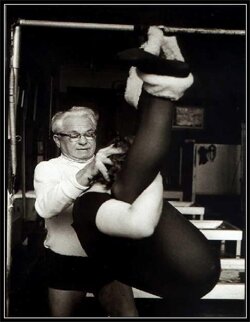 |
|
Joseph Pilates employing inverted brachiated flexion.
|
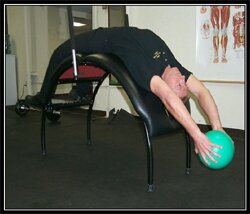 |
|
LTC William Rieger, Commandant of the United States Army Physical Fitness School demonstrates horizontal extension on a Body Bridge.
|
Not all physical educators ignored or rejected Martin’s methods during those years. In a 1986 letter to him, past president of the AAHPERD and a former professor at The University of Iowa B.D. Lockhardt wrote, “If the AAHPERD embraces the concepts you teach and modifies its fitness assessments accordingly, every child in physical education classes throughout American will be positively affected by your ideas. I am hopeful that we will make these adjustments as soon as possible and start on a steady and sensible program of preventing back pain long before it starts.”
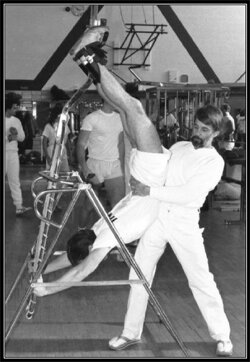 |
|
Thomas facilitates inverted brachiated extension at Northern Illinois University.
|
I introduced Martin’s theory of six postures to thousands of students at Northern Illinois University between 1979 and 1993. I taught students in Korea, Germany, Burma and Thailand to invert, extend and brachiate. Most recently, I worked with the United States Army to implement inversion Army-wide. First tested by U.S. Army Rangers in the mid-1990’s, the United States Army Physical Fitness School now recommends inverted decompression and mobilization as an integral part of physical readiness training for all U.S. soldiers. After almost thirty years of teaching people to employ these simple but uncommon postures, it remains for me a mystery that such obvious principles of posture and body management are not widespread and mainstream practice.
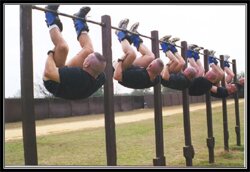 |
|
United States Army Rangers practice inverted sit-ups at Fort Benning, Georgia
|
Martin’s message is uniquely suited for our time, and we are wise to again consider the complicated notions he eloquently translated into simple and compelling language. “Examples of the consequences of not living compatibly with gravity and Newtonian Law are found everywhere,” He wrote. “One needs only to look at his neighbor and his drooping, shortening, sagging stature; bulged out mid-section, and unsightly posterior to see the devastating effects of gravity, illustrating how important it is to live compatibly with this major environmental influence. Too many of us are models of molding tissue living without concern for gravity's guiding power - a power we must learn to respect and use positively. The body is not only molded by the force of gravity, but it is conditioned by it. Gravity has been cast in the role of a villain instead of being seen in its proper light, namely a servant of mankind. It is the limiting of motion and fixation of posture that allows the force of gravity to warp the body and thus cause common backache.”
There is, of course, much to consider if and when the physical education profession begins to rebuild the posture and body mechanics curriculum. Martin’s pioneering work can certainly provide a start point, but many others past and present have dedicated their professional efforts to these issues. If and when we decide to develop posture and body mechanics curriculums that actually make a difference in our students’ lives, we will be pleasantly surprised that much of the work has already been done by those before us who lived close enough to Nature to see the simplicity and logic of Her eternal laws.
To reach Ed Thomas, Ed.D. at the Iowa Department of Education, call . Website www.ihpra.org.
Recommended Sources
1. Bennett, H.E. (1928). School posture and seating. Boston: Ginn and Company.
2. Devries, H.A. (1985, October-November). Inversion devices: Potential benefits and precautions. Corporate Fitness & Recreation, 4 (6), 24-27.
3. Drew, L.C. (1927). Adapted group gymnastics. Philadelphia: Lea & Febiger.
4. Drew, L.C. (1929). Individual gymnastics. Philadelphia: Lea & Febiger.
5. Goldthwaite, J.E. (1934). Body mechanics. Philadelphia: J.B. Lippincott Company.
6. Howland, I.H. (1936). The teaching of body mechanics. New York: A.S. Barnes.
7. Jacobsen, E. (1929). Progressive relaxation. Chicago: The University Press.
8. Lee, M., & Wagner, M. (1949). Fundamentals of body mechanics and conditioning. Philadelphia: W.B. Saunders.
9. Lippitt, L.C. (1923). A manual of corrective gymnastics. New York: The Macmillan Company.
10. Lovett, R.W. (1922). Lateral curvature of the spine and round shoulders. 5th ed., Philadelphia: P. Blakiston’s Son and Company Incorporated.
11. Lowman, C.L., Colestock, C., & Cooper, H. (1928). Corrective physical education for groups. New York: A.S. Barnes and Company.
12. Martin, R.M. (1975). Cum gravity-Living with gravity. San Marino, CA: Essential Publishing.
13. Martin, R.M. (1979). The gravity guiding system-Turning the aging process upside down. San Marino, CA: Essential Publishing.
14. McKenzie, R.T. (1923). Exercise in education and medicine. Philadelphia: W.B. Saunders Company.
15. Mesendieck, B.M. (1931). It’s up to you-The Mesendieck system. New York: 36 West Fifty-ninth St.
16. Metheny, E. (1986). Movement and meaning. New York: McGraw-Hill.
17. Pearl, N.H. & Brown, H.E. (1919). Health by stunts. New York: Macmillan Company.
18. Rathbone, J.L. (1934). Corrective physical education. Philadelphia: W.B. Saunders Company.
19. Richardson, F.H., & Hearn, W. J. (1930). The preschool child and his posture. New York: G.P. Putman’s Sons.
20. Spencer, H. (1886). Education: Intellectual, moral, and physical. New York: Appleton.
21. Staley, S.C. (1926). Calisthenics. New York: A.S. Barnes and Company.
22. Sumption, D. (1929). Fundamental Danish gymnastics. New York: A.S, Barnes and Company.
23. Stafford, G.T. (1928). Preventive and corrective physical education. New York: A.S. Barnes and Company.
24. Thomas, E.J. (1993). Decompression and mobilization-Down but not out of the gymnasium. The Physical Educator, 50, 39-46.
25. Thomas, L., & Goldthwaite, J.E. (1922). Body mechanics and health. Boston: Houghton Mifflin Company.
26. Todd, M. (1937). The thinking body. Boston: Charles T. Branford Company.
27. White House Conference. (1932). Body mechanics in education and practice. Washington: Library of Congress.